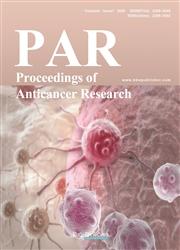The Diagnostic Value of Fecal Fusobacterium nucleatum Combined with FIT and CA199 in the Diagnosis of Colorectal Cancer
引用次数: 0
Abstract
Objective: To analyze the diagnostic value of fecal Fusobacterium nucleatum detection, fecal immunochemical test (FIT), and carbohydrate antigen 19-9 (CA19-9) detection for colorectal cancer (CRC). Method: A total of 78 CRC patients and 60 healthy individuals were enrolled in this study. Stool and blood samples were collected for the 3 diagnoses, and ROC curves were analyzed for diagnostic value. Result: The 3 diagnoses’ positive detection rates in CRC samples were significantly higher than those of healthy samples (P < 0.05). The combined CRC diagnoses showed significantly higher sensitivity as compared to individual fecal F. nucleatum detection (χ2 = 6.495, P = 0.011), FIT (χ2 = 4.871, P = 0.027), and serum CA19-9 detection (χ2 = 7.371, P = 0.007). The area under the ROC curve for fecal F. nucleatum detection was 0.63 [95% confidence interval (CI) = 1.124–6.238], with a sensitivity of 73.08% and specificity of 85.00%, whereas FIT was 0.65 (95% CI = 1.365–9.241), with a sensitivity of 51.28% and specificity of 96.67%, meanwhile, serum CA19-9 detection was 0.62 (95% CI = 1.517–12.342), with a sensitivity of 69.23% and specificity of 98.33%. The combined CRC diagnoses showed an area under the ROC curve of 0.76 (95% CI = 1.213–6.254), with a sensitivity of 87.18% and specificity of 70.00%. Conclusion: The combined diagnoses of fecal F. nucleatum detection, FIT, and serum CA19-9 detection can significantly improve the sensitivity and accuracy of CRC diagnosis, which has high clinical application value to provide guidance for clinical CRC screening and early intervention treatment.粪便有核梭杆菌联合FIT和CA199对癌症大肠癌的诊断价值
目的:分析粪便有核梭杆菌检测、粪便免疫化学试验(FIT)、糖类抗原19-9(CA19-9)检测对癌症(CRC)的诊断价值。方法:共有78名CRC患者和60名健康人参加本研究。收集粪便和血液样本用于3种诊断,并分析ROC曲线的诊断价值。结果:三种诊断方法在CRC中的阳性检出率均显著高于健康对照组(P<0.05),联合诊断的敏感性均显著高于单个粪便有核F.nucleanum检测(χ2=6.495,P=0.011)、FIT(χ2=4.871,P=0.027),和血清CA19-9检测(χ2=7.371,P=0.007)。粪便有核镰刀菌检测的ROC曲线下面积为0.63[95%置信区间(CI)=1.124–6.238],灵敏度为73.08%,特异性为85.00%,而FIT为0.65(95%CI=1.365–9.241),灵敏度为51.28%,特异度为96.67%,血清CA19-9检测为0.62(95%CI=1.517-12.342),敏感性为69.23%,特异性为98.33%。CRC联合诊断显示ROC曲线下面积为0.76(95%CI=1.213-6.254),灵敏度为87.18%,特异度为70.00%,血清CA19-9检测可显著提高CRC诊断的敏感性和准确性,对临床CRC筛查和早期干预治疗具有较高的临床应用价值。
本文章由计算机程序翻译,如有差异,请以英文原文为准。
求助全文
约1分钟内获得全文
求助全文

 求助内容:
求助内容: 应助结果提醒方式:
应助结果提醒方式:


